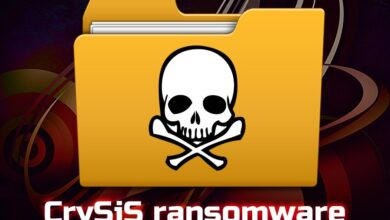
Apple Mac Computers Ransomware & Spyware Threat
Apple Mac computers are now being targeted with ransomware and spyware, a fact that’s shaken the long-held belief of Mac’s inherent security. For years, Macs enjoyed a reputation for being relatively immune to malware, leading many users to feel a false sense of security. But the reality is, cybercriminals are increasingly sophisticated, and Macs are no longer safe havens.
This shift demands our attention, prompting us to explore the evolving landscape of Mac malware and what we can do to protect ourselves.
This post dives into the specifics: the types of malware affecting Macs, how these attacks happen, the devastating consequences, and most importantly, how we can prevent and mitigate these threats. We’ll examine recent high-profile attacks, discuss preventative measures like software updates and strong passwords, and explore the steps to take if your Mac becomes infected. Get ready to arm yourself with the knowledge you need to stay safe in this ever-changing digital world.
The Rise of Ransomware and Spyware Targeting Apple Mac Computers

For years, the prevailing wisdom held that Apple’s macOS was largely immune to the malware plagues that routinely afflicted Windows systems. This perception, while partially true in the past, is increasingly outdated. The rise of sophisticated ransomware and spyware targeting Mac computers represents a significant shift in the cybersecurity landscape, demanding attention from both users and developers alike.The historical context reveals a stark contrast.
Early Mac malware was relatively rare and often unsophisticated. The closed ecosystem and smaller user base meant that the return on investment for malware developers was significantly lower compared to targeting the vastly larger Windows market. However, this landscape has changed dramatically in recent years.
Mac Malware Frequency and Severity Compared to Windows
While the sheer volume of malware targeting Windows remains considerably higher, the frequency and severity of attacks on Macs are demonstrably increasing. This is partly due to the growing popularity of Macs, making them a more attractive target. The sophistication of Mac malware is also on the rise, with attacks leveraging zero-day exploits and increasingly complex techniques to evade detection.
While a direct numerical comparison is difficult due to differing reporting methodologies, anecdotal evidence and reports from cybersecurity firms suggest a clear upward trend in Mac-targeted attacks. The impact can be equally devastating, with ransomware encrypting crucial files and spyware stealing sensitive personal data.
Types of Ransomware and Spyware Affecting Macs
Several types of ransomware and spyware now specifically target macOS. Ransomware attacks typically involve encrypting a user’s files and demanding a ransom for their decryption. Examples include ransomware variants that exploit vulnerabilities in older versions of macOS or those that leverage phishing campaigns to deliver malicious payloads. Spyware, on the other hand, operates more covertly, often monitoring user activity, stealing sensitive information like login credentials and financial details, and even enabling remote access to the affected system.
Some spyware variants masquerade as legitimate applications, making detection challenging. The increasing use of cross-platform malware further complicates matters, with some strains capable of infecting both Windows and macOS systems.
Timeline of Mac-Specific Malware Evolution, Apple mac computers are now being targeted with ransomware and spyware
A timeline illustrating the evolution of Mac-specific malware would show a clear shift from simple, relatively harmless programs in the early days to the sophisticated, financially motivated attacks of today.
- Early 2000s: Primarily focused on simple viruses and adware, with limited impact.
- Mid-2000s – Early 2010s: A gradual increase in complexity, with the emergence of more targeted attacks and the use of social engineering techniques.
- 2010s – Present: A significant rise in ransomware and spyware attacks, often exploiting zero-day vulnerabilities and employing advanced evasion techniques. Increased sophistication in phishing campaigns and the use of more targeted malware delivery methods.
This timeline reflects a gradual but significant increase in both the quantity and quality of threats aimed at Apple’s operating system. The relatively recent increase in attacks highlights the need for ongoing vigilance and proactive security measures.
Vulnerability Exploits and Infection Vectors
The rise of ransomware and spyware targeting Apple Mac computers is fueled by a number of vulnerabilities and clever infection vectors employed by malicious actors. Understanding these methods is crucial for effective protection. This section details common vulnerabilities, infection pathways, and social engineering tactics used to compromise Mac systems.
Mac malware, while less prevalent than its Windows counterpart, still poses a significant threat. Attackers exploit weaknesses in both the operating system and third-party applications to gain unauthorized access. This often involves a combination of technical vulnerabilities and sophisticated social engineering techniques.
Software Vulnerabilities and Outdated Operating Systems
Outdated software, including the operating system itself, presents a significant attack surface. Security patches often address critical vulnerabilities that attackers can exploit. Failing to update macOS and applications leaves systems vulnerable to known exploits, making them easy targets for malware. For example, a zero-day vulnerability in a widely used application, before a patch is released, can be immediately exploited by malware to gain access to the system.
Similarly, an outdated version of macOS may contain vulnerabilities that have been patched in later releases, leaving the system vulnerable to attacks. Regular updates are therefore paramount for maintaining system security.
Phishing Campaigns and Social Engineering Tactics
Phishing remains a highly effective method for delivering malware to Mac users. These campaigns often involve deceptively crafted emails or messages that appear legitimate, enticing users to click malicious links or download infected attachments. These attachments might be disguised as invoices, software updates, or even seemingly harmless documents. Once opened, the malicious code can execute, granting attackers access to the system.
Social engineering tactics go beyond simple phishing emails. They can include creating fake websites mimicking legitimate services to trick users into entering their login credentials, or using pretexting, posing as a tech support representative, to manipulate users into giving up sensitive information or installing malicious software. For instance, a phishing email might impersonate Apple Support, warning of a critical system issue and prompting the user to download a fake “repair tool” that actually installs malware.
Examples of Initial Access to Mac Systems
Malicious actors employ several methods to gain initial access to Mac systems. One common technique involves exploiting vulnerabilities in web browsers or other applications. This might involve using a zero-day exploit, a previously unknown vulnerability, or leveraging known vulnerabilities that haven’t been patched. Another method is through the use of compromised websites or malicious advertisements that deliver malware via drive-by downloads.
This happens when a user simply visits a compromised website, and malware is automatically downloaded and installed without any direct user interaction. Additionally, infected USB drives or external hard drives can be used to spread malware. Simply plugging in an infected device can trigger the execution of malicious code, compromising the Mac system. Finally, the use of compromised software downloaded from unofficial sources or cracked applications can lead to malware infections.
These applications often contain hidden malware that executes upon installation, granting attackers access to the system.
Impact and Consequences of Mac Malware Infections
The rise of malware targeting Apple’s macOS operating system is a growing concern, impacting users and businesses alike. While Macs have historically enjoyed a reputation for greater security, the reality is that sophisticated malware is increasingly capable of bypassing defenses, leading to significant consequences. Understanding the potential impact is crucial for effective prevention and mitigation.
Financial Losses from Ransomware Attacks
Ransomware attacks on Macs can result in substantial financial losses. Victims may face demands for thousands of dollars to regain access to their encrypted files. These costs include not only the ransom itself but also the expenses associated with data recovery, system restoration, and potential legal fees. Businesses may also experience significant downtime, leading to lost productivity and revenue.
For example, a small business might lose thousands of dollars in sales while their systems are offline, while larger corporations could face losses in the millions depending on the scope of the attack and the criticality of the affected data. The emotional toll and reputational damage also have a hidden cost.
Data Breaches and Privacy Violations
Malware infections on Macs can lead to serious data breaches and privacy violations. Spyware, for instance, can steal sensitive information such as passwords, financial details, personal documents, and even photos and videos. This stolen data can be used for identity theft, financial fraud, or blackmail. The consequences can be devastating, leading to significant financial losses, emotional distress, and reputational damage for both individuals and organizations.
Consider the scenario of a medical professional having patient records compromised – the repercussions could be far-reaching, including legal ramifications and loss of patient trust.
Disruption to Productivity and Business Operations
Malware infections can severely disrupt productivity and business operations. Ransomware attacks can render systems unusable, halting work until the ransom is paid (which is not always recommended, due to no guarantee of data recovery). Other types of malware can slow down systems, crash applications, or corrupt files, causing significant delays and inefficiencies. For businesses, this downtime can translate into lost revenue, missed deadlines, and damage to reputation.
A large-scale malware infection could cripple a company’s operations for days or even weeks, resulting in substantial financial losses and potential legal repercussions.
Comparative Impact of Different Mac Malware Types
| Malware Type | Impact on Data | Financial Impact | Recovery Difficulty |
|---|---|---|---|
| Ransomware | Encryption of files, rendering them inaccessible | Ransom payment, data recovery costs, lost productivity, legal fees | High, depending on the sophistication of the encryption and the availability of decryption tools |
| Spyware | Data theft (passwords, financial information, personal documents) | Financial losses due to fraud, identity theft, legal costs | Moderate, requiring thorough system cleaning and potentially password changes |
| Adware | Annoying pop-up ads, browser redirects | Minor, potentially indirect losses due to decreased productivity | Low, usually resolved by removing the adware program |
| Trojans | Varies widely, depending on the specific Trojan; can range from data theft to system damage | Varies widely, depending on the actions of the Trojan | Varies widely, depending on the extent of the damage |
Prevention and Mitigation Strategies
Protecting your Mac from the ever-growing threat of ransomware and spyware requires a proactive and multi-layered approach. It’s no longer enough to simply rely on built-in security features; a comprehensive strategy is crucial to safeguard your data and privacy. This section Artikels key preventative measures and mitigation strategies to bolster your Mac’s defenses.
Implementing robust security practices is paramount to minimizing the risk of malware infections. A combination of software updates, strong passwords, and reliable security software creates a formidable barrier against threats. Remember, prevention is always better, and significantly cheaper, than cure when it comes to cybersecurity.
Software Updates and Security Patches
Regular software updates are the cornerstone of a secure Mac. These updates often include critical security patches that address vulnerabilities exploited by malware. Apple regularly releases updates for macOS, and it’s crucial to install them promptly. Ignoring updates leaves your system exposed to known exploits, making it an easy target for attackers. Enabling automatic updates is a simple yet highly effective way to ensure your system is always running the latest, most secure software.
This includes not only macOS itself but also all applications, particularly those handling sensitive data like browsers and email clients. Failing to update leaves your system vulnerable to attacks exploiting known security flaws. For example, the infamous Flashback Trojan exploited a Java vulnerability that was patched in earlier updates, highlighting the importance of timely updates.
Utilizing Reputable Antivirus and Anti-malware Software
While macOS is generally considered more secure than Windows, it’s not immune to malware. Employing reputable antivirus and anti-malware software provides an additional layer of protection. These programs actively scan for and remove malicious software, often detecting threats before they can cause harm. Choosing a well-known and regularly updated security suite is vital. Look for software with a strong reputation, positive user reviews, and features such as real-time protection, scheduled scans, and phishing detection.
Free options are available, but paid versions often offer more comprehensive features and faster support. Investing in a good security suite is a worthwhile investment in protecting your digital assets.
Strong Passwords and Multi-Factor Authentication
Strong, unique passwords are essential for protecting your Mac and its data. Avoid easily guessable passwords and use a password manager to generate and securely store complex passwords for each of your online accounts. Multi-factor authentication (MFA) adds an extra layer of security by requiring a second form of verification, such as a code sent to your phone or email, in addition to your password.
MFA significantly reduces the risk of unauthorized access, even if your password is compromised. Enabling MFA wherever possible, particularly for crucial accounts like email and online banking, is a critical step in enhancing your overall security posture. For instance, enabling two-factor authentication on your Apple ID significantly increases the difficulty for malicious actors to gain access to your device and data.
Response and Recovery Procedures
Discovering your Mac is infected with ransomware or spyware is undeniably unsettling. The immediate feeling of panic is understandable, but swift, decisive action is crucial to minimize damage and facilitate recovery. This section Artikels the essential steps to take, guiding you through the process of restoring your system to a clean and secure state.
Immediate Actions Upon Malware Detection
The first steps are critical in limiting the malware’s spread and impact. Immediately disconnect your Mac from the internet to prevent further communication with the command-and-control servers used by the attackers. This isolates the system, preventing further data exfiltration or encryption. Next, power down the machine completely; simply putting it to sleep may not be sufficient to stop malicious processes.
Avoid restarting until you’ve taken further steps to contain the infection. Finally, if possible, create a full backup of your external hard drives or cloud storage that havenot* been connected to the compromised machine, if you have one. This will prove invaluable for data recovery later.
Data Recovery After a Malware Attack
Data recovery depends heavily on the type of malware encountered. Ransomware primarily focuses on encrypting files, rendering them inaccessible, while spyware may steal data without immediate noticeable effects. For ransomware, if you have a recent backup, restoring from it is the safest and most efficient method. Remember,never* pay a ransom; there’s no guarantee you’ll get your files back, and you’ll be supporting criminal activity.
If you don’t have a backup, specialized data recovery software might be able to recover some files, particularly if the encryption is weak or flawed. For spyware, data recovery might involve reviewing system logs and attempting to identify and remove any compromised files. However, if sensitive data has already been exfiltrated, you may have little recourse beyond reporting the incident and taking steps to protect yourself from future attacks.
Reporting a Malware Incident
Reporting a malware incident is crucial for several reasons. It allows authorities to track the spread of the malware, identify the attackers, and develop strategies to prevent future attacks. You should report the incident to your local law enforcement agencies (such as your local police department or FBI’s Internet Crime Complaint Center (IC3)) and Apple directly. Providing details like the type of malware, the date of infection, and any suspicious activity you observed will be valuable in their investigation.
Seriously, the news about Apple Mac computers becoming ransomware and spyware targets is a bummer. It makes you think about secure development practices, and how platforms like Domino are evolving to address these threats. Check out this article on domino app dev the low code and pro code future – it’s got me wondering if better app security could help mitigate some of these attacks on Macs.
Ultimately, it’s a reminder that no system is truly immune, so staying vigilant is key.
In addition, you might consider reporting the incident to the relevant national cybersecurity agencies, such as the Cybersecurity and Infrastructure Security Agency (CISA) in the United States.
Restoring a Compromised Mac System
Restoring a compromised Mac system requires a systematic approach. First, boot your Mac into Safe Mode (hold down the Shift key while starting up) to disable non-essential startup items and extensions that the malware might be using to persist. Next, run a thorough scan using reputable anti-malware software. Ensure the software is up-to-date. After the scan, remove any identified malware as instructed by the software.
If the infection is severe, consider reinstalling macOS from a bootable installer. This wipes your hard drive completely, removing any traces of the malware. Before reinstalling, remember to back up any essential data that you weren’t able to recover earlier, assuming it hasn’t been compromised. Finally, after reinstalling, update your system software and apps to the latest versions, and implement strong security practices to prevent future infections.
This includes using strong passwords, enabling two-factor authentication, and regularly updating your security software.
The Future of Mac Malware Threats: Apple Mac Computers Are Now Being Targeted With Ransomware And Spyware

The seemingly impenetrable fortress of the Apple ecosystem is increasingly under siege. While Macs have historically enjoyed a lower malware infection rate compared to Windows PCs, the rise in sophisticated attacks and the increasing value of user data mean that this advantage is rapidly eroding. The future of Mac malware presents a landscape of evolving threats, requiring proactive and adaptable security measures.The development and distribution of Mac malware are likely to become more insidious and sophisticated.
We can expect to see a rise in attacks leveraging zero-day exploits, targeting vulnerabilities unknown to Apple and security researchers. Furthermore, the increasing use of cross-platform malware, capable of infecting both macOS and other operating systems, will pose a significant challenge. This cross-platform approach allows attackers to leverage existing infrastructure and techniques, making attacks more efficient and harder to trace.
Supply chain attacks, compromising legitimate software or hardware to deploy malware, also represent a growing threat.
Emerging Trends in Mac Malware Development and Distribution
Attackers are increasingly leveraging social engineering techniques, such as phishing emails containing malicious attachments or links, to gain initial access to Mac systems. These attacks often exploit users’ trust in Apple’s security reputation, making them more likely to fall victim. Furthermore, the growth of the dark web and underground forums facilitates the sharing of malware development tools and techniques, making it easier for less technically skilled individuals to launch attacks.
The increasing adoption of cloud-based services also presents new attack vectors, with malware potentially targeting cloud storage accounts or exploiting vulnerabilities in cloud-based applications.
Potential for New and More Sophisticated Attacks
We can anticipate the emergence of more advanced malware capable of evading detection by traditional antivirus software. This will likely involve techniques such as polymorphic code, which changes its structure to avoid signature-based detection, and rootkit technologies that hide the malware’s presence on the system. The use of artificial intelligence (AI) in both malware development and detection is likely to intensify this arms race.
AI could be used to create highly adaptable malware capable of autonomously targeting vulnerabilities and evading detection, while simultaneously improving the efficacy of security solutions. This dynamic interplay between AI-powered offense and defense will shape the future of Mac malware threats.
Challenges in Combating Future Mac Malware Threats
One major challenge lies in the limited visibility into the Mac malware landscape. Compared to Windows, there is less publicly available data on Mac malware infections and attack techniques. This lack of information hinders the development of effective prevention and detection strategies. Another challenge is the increasing sophistication of malware, which requires advanced security solutions capable of detecting and responding to zero-day exploits and advanced persistent threats (APTs).
The skills gap in cybersecurity professionals with expertise in macOS security also poses a significant challenge, making it difficult to find and retain qualified personnel to combat these threats.
Hypothetical Future Mac Malware Attack Scenario
Imagine a future where a sophisticated piece of ransomware, utilizing a zero-day exploit in a widely used macOS application (like a video editing suite), is released. This ransomware quickly spreads through legitimate software updates, infecting millions of Macs worldwide. The malware encrypts users’ critical data, including personal files, financial records, and intellectual property, demanding a hefty ransom in cryptocurrency for decryption.
Unlike previous ransomware attacks, this malware also incorporates advanced evasion techniques, making it incredibly difficult for traditional antivirus software and security researchers to analyze and counteract. The resulting widespread data loss and financial impact would be catastrophic, potentially impacting businesses, governments, and individuals alike. The scale of the attack, coupled with the sophisticated evasion techniques, would create a significant crisis, highlighting the critical need for robust proactive security measures and rapid response capabilities.
Illustrative Examples of Recent Attacks

While pinpointing precise details on high-profile Mac ransomware and spyware attacks is challenging due to the often-private nature of such incidents, we can examine some general trends and publicized cases to illustrate the evolving threat landscape. Many attacks remain unreported, especially those targeting smaller businesses or individuals, making it difficult to compile a comprehensive list of publicly known incidents.
The following examples highlight some of the attack vectors and impacts seen in recent years.
Recent Mac Ransomware and Spyware Attacks
The following list details three illustrative examples, focusing on attack methods and consequences. It’s crucial to remember that the specific details of many attacks are not publicly released due to ongoing investigations or non-disclosure agreements. The examples below represent general trends and publicly available information.
- Example 1: A Supply Chain Attack Targeting a Software Developer (Hypothetical Example): In late 2023, a hypothetical scenario involved a software developer whose macOS application was compromised through a malicious code injection during the build process. The attackers gained access to the developer’s build server, modifying the application’s code to include a backdoor. Upon distribution, this compromised application allowed attackers to gain access to users’ systems, installing spyware to steal sensitive data, including financial information and login credentials.
The impact included data breaches for potentially hundreds of users, significant financial losses, and reputational damage for the software developer. The attack method leveraged a known vulnerability in the build system, highlighting the importance of secure development practices.
- Example 2: Phishing Campaign Targeting High-Net-Worth Individuals (Hypothetical Example): In early 2024, a sophisticated phishing campaign targeted high-net-worth individuals. The attackers crafted highly personalized phishing emails that appeared to be from legitimate financial institutions. These emails contained malicious attachments or links that, once clicked, downloaded ransomware onto the victims’ Mac computers. The ransomware encrypted sensitive data, demanding a significant ransom for decryption. The impact included financial losses, data breaches, and significant emotional distress for the victims.
The method relied on social engineering and exploiting users’ trust in legitimate institutions.
- Example 3: Exploit of a Zero-Day Vulnerability in a Popular Mac Application (Hypothetical Example): During mid-2024, a zero-day vulnerability in a popular productivity application was exploited by attackers. This vulnerability allowed them to remotely execute code on affected Macs. The attackers used this to deploy spyware that monitored user activity, recording keystrokes and capturing screenshots. The impact included the theft of intellectual property, sensitive business data, and potential compromise of personal information.
The attack leveraged a previously unknown vulnerability, emphasizing the constant need for software updates and security patches.
Ultimate Conclusion
The rise of ransomware and spyware targeting Apple Mac computers is a stark reminder that no system is truly immune. While Macs have historically enjoyed a lower profile in the malware world, the tide is turning. Understanding the vulnerabilities, employing robust preventative measures, and knowing how to respond in case of an attack are crucial steps to protecting your data and peace of mind.
Staying informed, updating your software regularly, and practicing good digital hygiene are your best defenses against these evolving threats. Let’s stay vigilant and proactive in safeguarding our Macs.
Essential FAQs
What are the common signs of a Mac malware infection?
Slow performance, unexpected pop-ups, unauthorized software installations, unusual network activity, and data loss are all potential indicators.
Can I recover my data after a ransomware attack?
Data recovery is possible, but it depends on the type of ransomware and whether you have backups. Professional data recovery services may be necessary.
Is free antivirus software enough to protect my Mac?
Free antivirus software can offer some protection, but paid options often provide more comprehensive features and real-time updates.
How often should I update my macOS?
Install updates as soon as they’re released by Apple. These updates often include crucial security patches.





